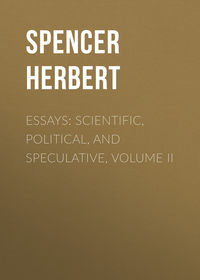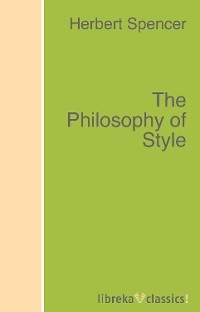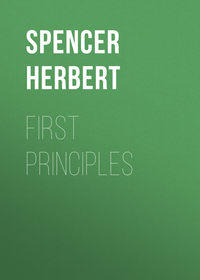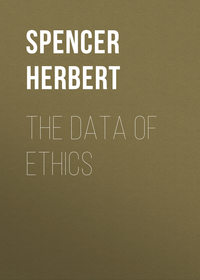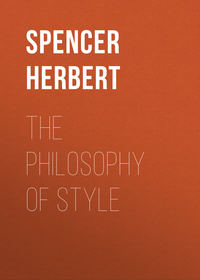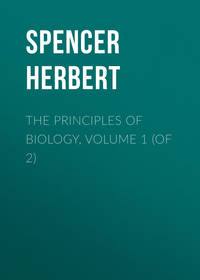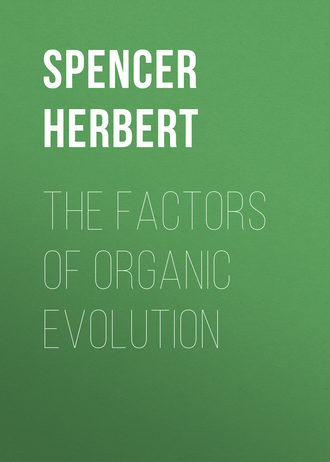 полная версия
полная версияThe Factors of Organic Evolution
If, now, inorganic masses, relatively so stable in composition, thus have their outer parts differentiated from their inner parts, what must we say of organic masses, characterized by such extreme chemical instability? – instability so great that their essential material is named protein, to indicate the readiness with which it passes from one isomeric form to another. Clearly the necessary inference is that this effect of the medium must be wrought inevitably and promptly, wherever the relation of outer and inner has become settled: a qualification for which the need will be seen hereafter.
Beginning with the earliest and most minute kinds of living things, we necessarily encounter difficulties in getting direct evidence; since, of the countless species now existing, all have been subject during millions upon millions of years to the evolutionary process, and have had their primary traits complicated and obscured by those endless secondary traits which the natural selection of favourable variations has produced. Among protophytes it needs but to think of the multitudinous varieties of diatoms and desmids, with their elaborately-constructed coverings; or of the definite methods of growth and multiplication among such simple Algæ as the Conjugatæ; to see that most of their distinctive characters are due to inherited constitutions, which have been slowly moulded by survival of the fittest to this or that mode of life. To disentangle such parts of their developmental changes as are due to the action of the medium, is therefore hardly possible. We can hope only to get a general conception of it by contemplating the totality of the facts.
The first cardinal fact is that all protophytes are cellular – all show us this contrast between outside and inside. Supposing the multitudinous specialities of the envelope in different orders and genera of protophytes to be set against one another, and mutually cancelled, there remains as a trait common to them – an envelope unlike that which it envelopes. The second cardinal fact is that this simple trait is the earliest trait displayed in germs, or spores, or other parts from which new individuals are to arise; and that, consequently, this trait must be regarded as having been primordial. For it is an established truth of organic evolution that embryos show us, in general ways, the forms of remote ancestors; and that the first changes undergone, indicate, more or less clearly, the first changes which took place in the series of forms through which the existing form has been reached. Describing, in successive groups of plants, the early transformations of these primitive units, Sachs4 says of the lowest Algæ that “the conjugated protoplasmic body clothes itself with a cell-wall” (p. 10); that in “the spores of Mosses and Vascular Cryptogams” and in “the pollen of Phanerogams” … “the protoplasmic body of the mother-cell breaks up into four lumps, which quickly round themselves off and contract, and become enveloped by a cell-membrane only after complete separation” (p. 13); that in the Equisetaceæ “the young spores, when first separated, are still naked, but they soon become surrounded by a cell-membrane” (p. 14); and that in higher plants, as in the pollen of many Dicotyledons, “the contracting daughter-cells secrete cellulose even during their separation” (p. 14). Here, then, in whatever way we interpret it, the fact is that there quickly arises an outer layer different from the contained matter. But the most significant evidence is furnished by “the masses of protoplasm that escape into water from the injured sacs of Vaucheria, which often instantly become rounded into globular bodies,” and of which the “hyaline protoplasm envelopes the whole as a skin” (p. 41) which “is denser than the inner and more watery substance” (p. 42). As in this case the protoplasm is but a fragment, and as it is removed from the influence of the parent-cell, this differentiating process can scarcely be regarded as anything more than the effect of physico-chemical actions: a conclusion which is supported by the statement of Sachs that “not only every vacuole in a solid protoplasmic body, but also every thread of protoplasm which penetrates the sap-cavity, and finally the inner side of the protoplasm-sac which encloses the sap-cavity, is also bounded by a skin” (p. 42). If then “every portion of a protoplasmic body immediately surrounds itself, when it becomes isolated, with such a skin,” which is shown in all cases to arise at the surface of contact with sap or water, this primary differentiation of outer from inner must be ascribed to the direct action of the medium. Whether the coating thus initiated is secreted by the protoplasm, or whether, as seems more likely, it results from transformation of it, matters not to the argument. Either way the action of the medium causes its formation; and either way the many varied and complex differentiations which developed cell-walls display, must be considered as originating from those variations of this physically-generated covering which natural selection has taken advantage of.
The contained protoplasm of a vegetal cell, which has self-mobility and when liberated sometimes performs amœba-like motions for a time, may be regarded as an imprisoned amœba; and when we pass from it to a free amœba, which is one of the simplest types of first animals, or Protozoa, we naturally meet with kindred phenomena. The general trait which here concerns us, is that while its plastic or semi-fluid sarcode goes on protruding, in irregular ways, now this and now that part of its periphery, and again withdrawing into its interior first one and then another of these temporary processes, perhaps with some small portion of food attached, there is but an indistinct differentiation of outer from inner (a fact shown by the frequent coalescence of the pseudopodia in Rhizopods); but that when it eventually becomes quiescent, the surface becomes differentiated from the contents: the passing into an encysted state, doubtless in large measure due to inherited proclivity, being furthered, and having probably been once initiated, by the action of the medium. The connexion between constancy of relative position among the parts of the sarcode, and the rise of a contrast between superficial and central parts, is perhaps best shown in the minutest and simplest Infusoria, the Monadinæ. The genus Monas is described by Kent as “plastic and unstable in form, possessing no distinct cuticular investment; … the food-substances incepted at all parts of the periphery”;5 and the genus Scytomonas he says “differs from Monas only in its persistent shape and accompanying greater rigidity of the peripheral or ectoplasmic layer.”6 Describing generally such low forms, some of which are said to have neither nucleus nor vacuole, he remarks that in types somewhat higher “the outer or peripheral border of the protoplasmic mass, while not assuming the character of a distinct cell-wall or so-called cuticle, presents, as compared with the inner substance of that mass, a slightly more solid type of composition.”7 And it is added that these forms having so slightly differentiated an exterior, “while usually exhibiting a more or less characteristic normal outline, can revert at will to a pseud-amœboid and repent state.”8 Here, then, we have several indications of the truth that the permanent externality of a certain part of the substance, is followed by transformation of it into a coating unlike the substance it contains. Indefinite and structureless in the simplest of these forms, as instance again the Gregarina,9 the limiting membrane becomes, in higher Infusoria, definite and often complex: showing that the selection of favourable variations has had largely to do with its formation. In such types as the Foraminifera, which, almost structureless internally though they are, secrete calcareous shells, it is clear that the nature of this outer layer is determined by inherited constitution. But recognition of this consists with the belief that the action of the medium initiated the outer layer, specialized though it now is; and that even still, contact with the medium excites secretion of it.
A remarkable analogy remains to be named. When we study the action of the medium in an inorganic mass, we are led to see that between the outer changed layer and the inner unchanged mass, comes a surface where active change is going on. Here we have to note that, alike in the plant-cell and in the animal-cell, there is a similar relation of parts. Immediately inside the envelope comes the primordial utricle in the one case, and in the other case the layer of active sarcode. In either case the living protoplasm, placed in the position of a lining to the cuticle of the cell, is shielded from the direct action of the medium, and yet is not beyond the reach of its influences.
Limited, as thus far drawn, to a certain common trait of those minute organisms which are mostly below the reach of unaided vision, the foregoing conclusion appears trivial enough. But it ceases to appear trivial on passing into a wider field, and observing the implications, direct and indirect, as they concern plants and animals of sensible sizes.
Popular expositions of science have so far familiarized many readers with a certain fundamental trait of living things around, that they have ceased to perceive how marvellous a trait it is, and, until interpreted by the Theory of Evolution, how utterly mysterious. In past times, the conception of an ordinary plant or animal which prevailed, not throughout the world at large only but among the most instructed, was that it is a single continuous entity. One of these living things was unhesitatingly regarded as being in all respects a unit. Parts it might have, various in their sizes, forms, and compositions; but these were components of a whole which had been from the beginning in its original nature a whole. Even to naturalists fifty years ago, the assertion that a cabbage or a cow, though in one sense a whole, is in another sense a vast society of minute individuals, severally living in greater or less degrees, and some of them maintaining their independent lives unrestrained, would have seemed an absurdity. But this truth which, like so many of the truths established by science, is contrary to that common sense in which most people have so much confidence, has been gradually growing clear since the days when Leeuwenhoek and his contemporaries began to examine through lenses the minute structures of common plants and animals. Each improvement in the microscope, while it has widened our knowledge of those minute forms of life described above, has revealed further evidence of the fact that all the larger forms of life consist of units severally allied in their fundamental traits to these minute forms of life. Though, as formulated by Schwann and Schleiden, the cell-doctrine has undergone qualifications of statement; yet the qualifications have not been such as to militate against the general proposition that organisms visible to the naked eye, are severally compounded of invisible organisms – using that word in its most comprehensive sense. And then, when the development of any animal is traced, it is found that having been primarily a nucleated cell, and having afterwards become by spontaneous fission a cluster of nucleated cells, it goes on through successive stages to form out of such cells, ever multiplying and modifying in various ways, the several tissues and organs composing the adult.
On the hypothesis of evolution this universal trait has to be accepted not as a fact that is strange but unmeaning. It has to be accepted as evidence that all the visible forms of life have arisen by union of the invisible forms; which, instead of flying apart when they divided, remained together. Various intermediate stages are known. Among plants, those of the Volvox type show us the component protophytes so feebly combined that they severally carry on their lives with no appreciable subordination to the life of the group. And among animals, a parallel relation between the lives of the units and the life of the group is shown us in Uroglena and Syncrypta. From these first stages upwards, may be traced through successively higher types, an increasing subordination of the units to the aggregate; though still a subordination leaving to them conspicuous amounts of individual activity. Joining which facts with the phenomena presented by the cell-multiplication and aggregation of every unfolding germ, naturalists are now accepting the conclusion that by this process of composition from Protozoa, were formed all classes of the Metazoa10– (as animals formed by this compounding are now called); and that in a similar way from Protophyta, were formed all classes of what I suppose will be called Metaphyta, though the word does not yet seem to have become current.
And now what is the general meaning of these truths, taken in connexion with the conclusion reached in the last section. It is that this universal trait of the Metazoa and Metaphyta, must be ascribed to the primitive action and re-action between the organism and its medium. The operation of those forces which produced the primary differentiation of outer from inner in early minute masses of protoplasm, pre-determined this universal cell-structure of all embryos, plant and animal, and the consequent cell-composition of adult forms arising from them. How unavoidable is this implication, will be seen on carrying further an illustration already used – that of the shingle-covered shore, the pebbles on which, while being in some cases selected, have been in all cases rounded and smoothed. Suppose a bed of such shingle to be, as we often see it, solidified, along with interfused material, into a conglomerate. What in such case must be considered as the chief trait of such conglomerate; or rather – what must we regard as the chief cause of its distinctive characters? Evidently the action of the sea. Without the breakers, no pebbles; without the pebbles, no conglomerate. Similarly then, in the absence of that action of the medium by which was effected the differentiation of outer from inner in those microscopic portions of protoplasm constituting the earliest and simplest animals and plants, there could not have existed this cardinal trait of composition which all the higher animals and plants show us.
So that, active as has been the part played by natural selection, alike in modifying and moulding the original units – largely as survival of the fittest has been instrumental in furthering and controlling the combination of these units into visible organisms, and eventually into large ones; yet we must ascribe to the direct effect of the medium on the first forms of life, that character of which this everywhere-operative factor has taken advantage.
Let us turn now to another and more obvious attribute of higher organisms, for which also there is this same general cause. Let us observe how, on a higher platform, there recurs this differentiation of outer from inner – how this primary trait in the living units with which life commences, re-appears as a primary trait in those aggregates of such units which constitute visible organisms.
In its simplest and most unmistakable form, we see this in the early changes of an unfolding ovum of primitive type. The original fertilized single cell, having by spontaneous fission multiplied into a cluster of such cells, there begins to show itself a contrast between periphery and centre; and presently there is formed a sphere consisting of a superficial layer unlike its contents. The first change, then, is the rise of a difference between that outer part which holds direct converse with the surrounding medium, and that inclosed part which does not. This primary differentiation in these compound embryos of higher animals, parallels the primary differentiation undergone by the simplest living things.
Leaving, for the present, succeeding changes of the compound embryo, the significance of which we shall have to consider by-and-by, let us pass now to the adult forms of visible plants and animals. In them we find cardinal traits which, after what we have seen above, will further impress us with the importance of the effects wrought on the organism by its medium.
From the thallus of a sea-weed up to the leaf of a highly developed phænogam, we find, at all stages, a contrast between the inner and outer parts of these flattened masses of tissue. In the higher Algæ “the outermost layers consist of smaller and firmer cells, while the inner cells are often very large, and sometimes extremely long;”11 and in the leaves of trees the epidermal layer, besides differing in the sizes and shapes of its component cells from the parenchyma forming the inner substance of the leaf, is itself differentiated by having a continuous cuticle, and by having the outer walls of its cells unlike the inner walls.12 Especially significant is the structure of such intermediate types as the Liverworts. Beyond the differentiation of the covering cells from the contained cells, and the contrast between upper surface and under surface, the frond of Marchantia polymorpha clearly shows us the direct effect of incident forces; and shows us, too, how it is involved with the effect of inherited proclivities. The frond grows from a flat disc-shaped gemma, the two sides of which are alike. Either side may fall uppermost; and then of the developing shoot, the side exposed to the light “is under all circumstances the upper side which forms stomata, the dark side becomes the under side which produces root-hairs and leafy processes.”13 So that while we have undeniable proof that the contrasted influences of the medium on the two sides, initiate the differentiation, we have also proof that the completion of it is determined by the transmitted structure of the type; since it is impossible to ascribe the development of stomata to the direct action of air and light. On turning from foliar expansions, to stems and roots, facts of like meaning meet us. Speaking generally of epidermal tissue and inner tissue, Sachs remarks that “the contrast of the two is the plainer the more the part of the plant concerned is exposed to air and light.”14 Elsewhere, in correspondence with this, it is said that in roots the cells of the epidermis, though distinguished by bearing hairs, “are otherwise similar to those of the fundamental tissue” which they clothe,15 while the cuticular covering is relatively thin; whereas in stems the epidermis (often further differentiated) is composed of layers of cells which are smaller and thicker-walled: a stronger contrast of structure corresponding to a stronger contrast of conditions. By way of meeting the suggestion that these respective differences are wholly due to the natural selection of favourable variations, it will suffice if I draw attention to the unlikeness between imbedded roots and exposed roots. While in darkness, and surrounded by moist earth, the outermost protective coats, even of large roots, are comparatively thin; but when the accidents of growth entail permanent exposure to light and air, roots acquire coverings allied in character to the coverings of branches. That the action of the medium causes these and converse changes, cannot be doubted when we find, on the one hand, that “roots can become directly transformed into leaf-bearing shoots,” and, on the other hand, that in some plants certain “apparent roots are only underground shoots,” and that nevertheless “they are similar to true roots in function and in the formation of tissue, but have no root-cap, and, when they come to the light above ground, continue to grow in the manner of ordinary leaf-shoots.”16 If, then, in highly developed plants inheriting pronounced structures, this differentiating influence of the medium is so marked, it must have been all-important at the outset while types were undetermined.
As with plants so with animals, we find good reason for inferring that while the specialities of the tegumentary parts must be ascribed to the natural selection of favourable variations, their most general traits are due to the direct action of surrounding agencies. Here we come upon the border of those changes which are ascribable to use and disuse. But from this class of changes we may fitly exclude those in which the parts concerned are wholly or mainly passive. A corn and a blister will conveniently serve to illustrate the way in which certain outer actions initiate in the superficial tissues, effects of very marked kinds, which are related neither to the needs of the organism nor to its normal structure. They are neither adaptive changes nor changes towards completion of the type. After noting them we may pass to allied, but still more instructive, changes. Continuous pressure on any portion of the surface causes absorption, while intermittent pressure causes growth: the one impeding circulation and the passage of plasma from the capillaries into the tissues, and the other aiding both. There are yet further mechanically-produced effects. That the general character of the ribbed skin on the under surfaces of the feet and insides of the hands is directly due to friction and intermittent pressure, we have the proofs: – first, that the tracts most exposed to rough usage are the most ribbed; second, that the insides of hands subject to unusual amounts of rough usage, as those of sailors, are strongly ribbed all over; and third, that in hands which are very little used, the parts commonly ribbed become quite smooth. These several kinds of evidence, however, full of meaning as they are, I give simply to prepare the way for evidence of a much more conclusive kind.
Where a wide ulcer has eaten away the deep-seated layer out of which the epidermis grows, or where this layer has been destroyed by an extensive burn, the process of healing is very significant. From the subjacent tissues, which in the normal order have no concern with outward growth, there is produced a new skin, or rather a pro-skin; for this substituted outward-growing layer contains no hair-follicles or other specialities of the original one. Nevertheless, it is like the original one in so far that it is a continually renewed protective covering. Doubtless it may be contended that this make-shift skin results from the inherited proclivity of the type – the tendency to complete afresh the structure of the species when injured. We cannot, however, ignore the immediate influence of the medium, on recalling the facts above named, or on remembering the further fact that an inflamed surface of skin, when not sheltered from the air, will throw out a film of coagulable lymph. But that the direct action of the medium is a chief factor we are clearly shown by another case. Accident or disease occasionally causes permanent eversion, or protrusion, of mucous membrane. After a period of irritability, great at first but decreasing as the change advances, this membrane assumes the general character of ordinary skin. Nor is this all: its microscopic structure changes. Where it is a mucous membrane of the kind covered by cylinder-epithelium, the cylinders gradually shorten, becoming finally flat, and there results a squamous epithelium: there is a near approach in minute composition to epidermis. Here a tendency towards completion of the type cannot be alleged; for there is, contrariwise, divergence from the type. The effect of the medium is so great that, in a short time, it overcomes the inherited proclivity and produces a structure of opposite kind to the normal one.
With but little break we come here upon a significant analogy, parallel to an analogy already described. As was pointed out, an inorganic body that is modifiable by its medium, acquires, after a time, an outer coat which has already undergone such change as surrounding agencies can effect; has a contained mass which is as yet unchanged, because unreached; and has a surface between the two where change is going on – a region of activity. And we saw that alike in the vegetal cell and the animal cell there exist analogous distributions: of course with the difference that the innermost part is not inert. Now we have to note that in those aggregates of cells constituting the Metaphyta and Metazoa, analogous distributions also exist. In plants they are of course not to be looked for in leaves and other deciduous portions, but only in portions of long duration – stems and branches. Naturally, too, we need not expect them in plants having modes of growth which early produce an outer practically dead part, that effectually shields the inner actively living part of the stem from the influence of the medium – long-lived acrogens such as tree-ferns and long-lived endogens such as palms. But in the highest plants, exogens, which have the actively living part of their stems within reach of environing agencies, we find this part, – the cambium layer, – is one from which there is a growth inwards forming wood, and a growth outwards forming bark: there is an increasingly thick covering (where it does not scale off) of tissue changed by the medium, and inside this a film of highest vitality. In so far as concerns the present argument, it is the same with the Metazoa, or at least all of them which have developed organizations. The outer skin grows up from a limiting plane, or layer, a little distance below the surface – a place of predominant vital activity. Here perpetually arise new cells, which, as they develop, are thrust outwards and form the epidermis: flattening and drying up as they approach the surface, whence, having for a time served to shield the parts below, they finally scale off and leave younger ones to take their places. This still undifferentiated tissue forming the base of the epidermis, and existing also as a source of renewal in internal organs, is the essentially living substance; and facts above given imply that it was the action of the medium on this essentially living substance, which, during early stages in the organization of the Metazoa, initiated that protective envelope which presently became an inherited structure – a structure which, though now mainly inherited, still continues to be modifiable by its initiator.


